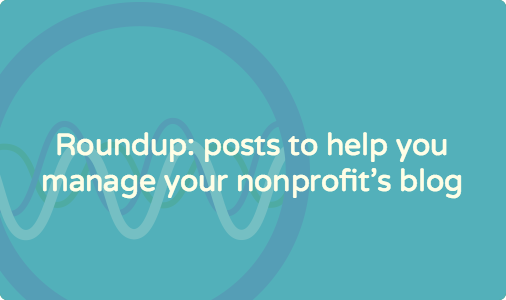This article originally appeared on the Nonprofit MarCommunity blog.
You know that life as a newsletter or blog publisher is easier when you have a plan and an editorial calendar, so you’ve decided to create one. You know that this calendar will essentially line up what content you’re going to publish, and when. But what factors will guide you to making the right decisions? When you’re creating editorial calendars for your nonprofit organization’s blog or newsletter, ask yourself these questions:
What content do your readers want?
If you’re creating an editorial calendar then you’re at the tactic development stage. This should mean that you’re planning a tactic that flows from an overall communications strategy, including goals and a defined audience that you want to reach or community with whom you’d like to engage. Using the audience personas that you created during strategic planning, brainstorm a list of content or topic ideas that you know your readers will love.
What messages do you want or need to deliver?
As much as you’d like to serve up only the content your readers are looking for, the reality is that there are a number of messages, campaigns and announcements that your nonprofit needs to deliver. Turning to strategic plans, communications plans and event or program calendars, make a list of the content your organization needs to deliver. What major events, announcements and promotions can you plan for? What less predictable events can you try to anticipate?
Who will/can write content for you?
Once this publication is up and running, who will be writing the content for you? Will it be all up to you or will you be working with a team of contributors? Spend time now thinking about the obvious – and not so obvious – colleagues, volunteers, board members, subject matter experts and others who can write or otherwise produce content for your publication.
How reliable are your contributors?
Another reality check: all contributors are not created equal when it comes to their reliability and ability to deliver on their commitments. There can be many reasons for this, so it’s important to give thought ahead of time to who will require more guidance, editing, management and back up plans (their content might be well worth it) and who will deliver exactly what you need, when you need it, without requiring any follow up. Put the higher-maintenance folks on the schedule less frequently because getting their content will require more work from you.
What content excites you and other contributors?
The more excited you and your other contributors can get about developing your content, the more likely you’ll be to enjoy working on it, to stick to your schedule and to get it done. Not to mention that the quality of the writing is likely to be higher when your enthusiasm is high, versus writing that feels like drudgery or a punishment.
What’s a reasonable amount of content to produce?
Now you have an amazing list of planned content that will delight your readers while delivering your organization’s core messages and calls to action. But how reasonable is your plan when is comes to implementation? Can you keep up with the volume that you have planned? If not, scale back and be conservative. Set yourself up for success; rather than ambitious, be realistic about how much content you can deliver consistently.
What’s a reasonable publishing schedule?
How often can you reasonably deliver your content? As with the volume of content you have planned, be mindful of how frequently you can get your publication before your readers. In addition to considering how much content you can produce, think about the systems, people and technology required to deliver each newsletter or publish each blog post – and how often you can tap into these. Favour predictability and consistency (over a difficult-to-achieve high frequency) so that your readers can get used to hearing from you on a regular basis – and look forward to it.
To what extent do you need to build in flexibility?
When putting content on the calendar, be aware of the extent to which you will have a firm plan or a loose guideline. Depending on your context, your autonomy, reviewers and sign-off, how certain are you that your articles, posts and updates will be able to go out as planned? Also, to what extent will you need to be responsive to internal requests to get other/new content on the schedule and out the door? Be aware of these factors when planning and be ready to be flexible if needed.
To what extent do you need backup plans?
When your calendar is starting to come together, step back to look and decide where back up plans might be needed. As I mentioned above, certain contributors might be less reliable/more work, in which case you’ll want to be ready with a plan ‘B’. You’ll also want to be mindful of content that might be difficult to pull together because it involves multiple players, hard-to-get photography, be tied to tentative events/launch dates or partners that are not yet confirmed, etc. An example of a great back up plan for publications: have a stockpile of ‘evergreen’ content that can go out any time there is a hole to fill.
There are many formats and ways to develop editorial calendars, so have fun with those (see below for resources and examples). And use your answers to the nine questions above to help shape your editorial calendars. Do you have any questions to add?
Editorial calendar articles and tools
- Editorial Calendars for Nonprofits – Resources for You from the Nonprofit Marketing Guide blog
- Become Your Own Publishing Powerhouse with LightBox Collaborative’s 2014 Editorial Calendar (downloadable and customizable template)
- Developing an Editorial Calendar for Your Nonprofit Marketing Team via Salsa blog
- Content Marketing: The Cliff Notes Approach to Editorial Calendars by Heidi Cohen
- How to Create a Nonprofit Editorial Calendar from the Network for Good blog




